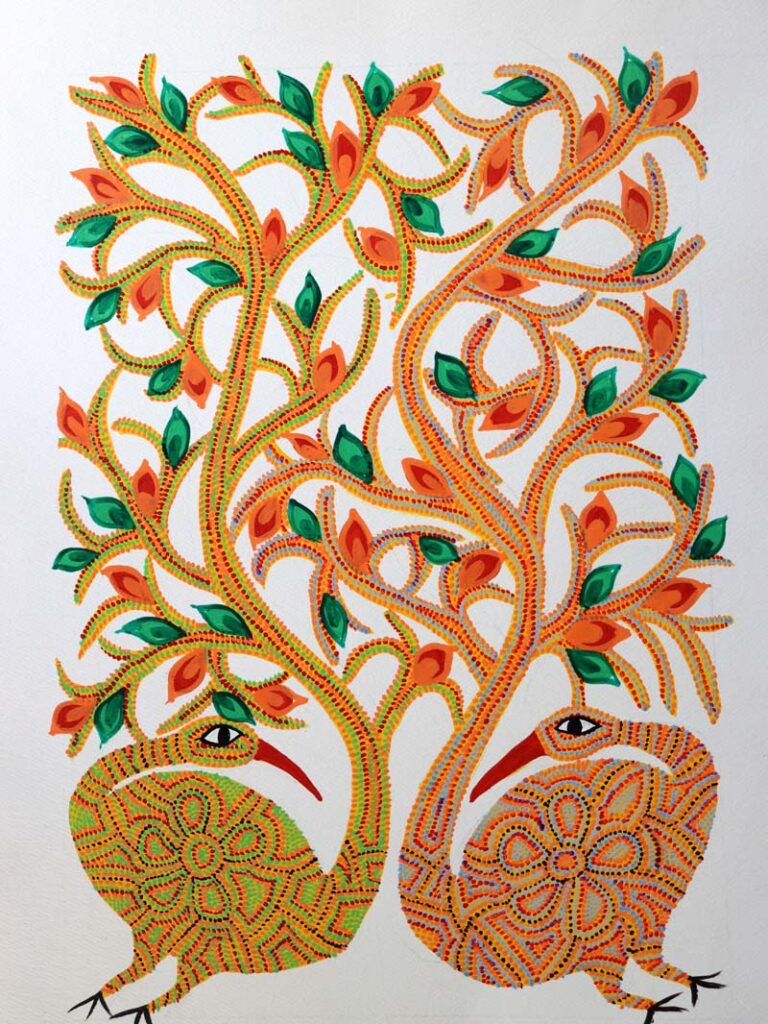Folk Paintings is a visual representation of a particular group of people’s common culture and contains customs unique to that culture, subculture, or group.
Madhubani Paintings
- Madhubani painting is a style of painting, practiced in the Mithila region of Bihar state.
- Themes revolve around Hindu Gods and mythology, along with scenes from the royal court and social events like weddings.
- Generally no space is left empty; the gaps are filled by paintings of flowers, animals, birds, and even geometric designs .
- Paintings are traditionally done on freshly plastered mud walls and floors of huts, but now they are also done on cloth, hand-made paper and canvas.
- Since there was no shading, the paintings are two-dimensional. Some of the common features of these paintings include double line border, bold use of colours, ornate floral patterns and exaggerated facial features.
- Painting is done with fingers, twigs, brushes, nib-pens and matchsticks, using natural dyes and pigments.
- Traditionally done by women by the region uses bright earthy colors.
- Characterized by eye-catching geometrical patterns.
- There are paintings for each occasion and festival such as birth, Holi, Kali Puja, etc.
- The figures in the painting were symbolic. For example, fish depicts good luck and fertility.
- The origin of Madhubani paintings is believed to be during the period of Ramayana, when the King of Mithila told people of his kingdom to paint walls and floors of their houses on the marriage of Sita and Rama.
- Mostly women have passed on the skill of Madhubani painting from generations to generations.
- In 1970, this art got recognition, when the President of India honoured Jagdamba Devi. Apart from her, other famous painters associated with this include Baua Devi, Bharti Dayal, Ganga Devi, Mahasundari Devi and Sita Devi.
- Since the art has remained confined to a specific geographical area, it has been given GI (geographical indication) status.
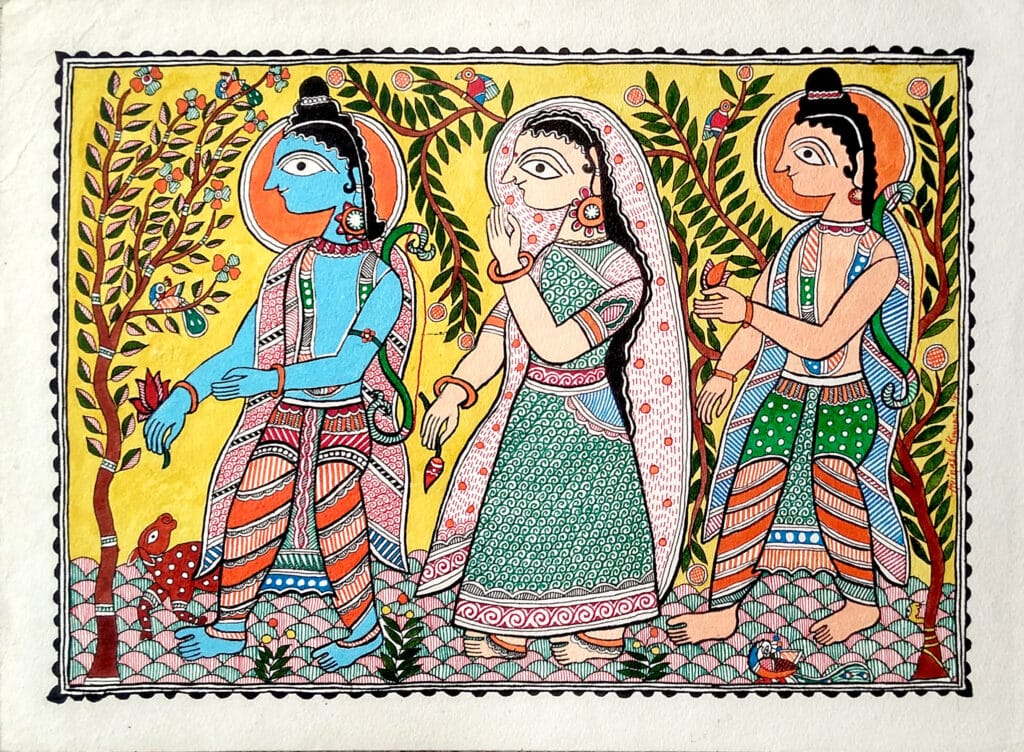
Pattachitra Paintings
- Pattachitra is a general term for traditional, clothbased scroll painting, based in the eastern Indian state, Odisha. In the Sanskrit language, “Patta” literally means “cloth” and “Chitra” means “picture”.
- These paintings are based on Hindu mythology and specially inspired by Jagannath and Vaishnava sect, sometimes from Shakti and Shaiva cults also.
- Paintings are done on small strips of cotton cloth. The canvas is prepared by coating the cloth with a mixture of chalk and gum made from tamarind seeds. Women traditionally make this gum and application.
- The master hand, mostly the male member, draws the initial line and gives the final finishing.
- The painting is held over a fire-place so that the back of the painting is exposed to heat. On the surface of the painting fine lacquer is applied.
- Natural colours are used. No pencil or charcoal is used.
- Tala Pattachitra is one variant of this form, drawn on palm leaf.
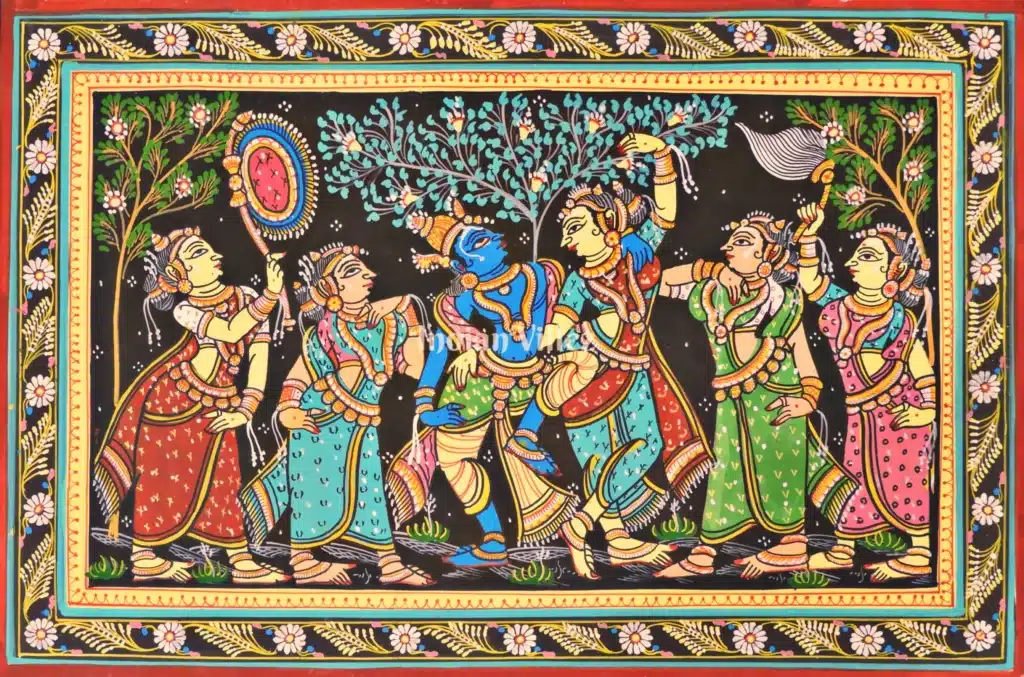
Kalighat Paintings
- Kalighat paintings originated in the 19th century Bengal, in the vicinity of Kalighat Kali Temple, Kolkata, India.
- From the depiction of Hindu gods, god, and other mythological characters, the Kalighat paintings developed to reflect a variety of themes.
- An important achievement of the Kalighat artistes was that they made simple paintings and drawings, which could easily be reproduced by lithography. Such prints were then hand coloured.
- The charm of the Kalighat paintings lies in the fact that they captured the essence of daily life and they influence modern artistes like the late Jamini Roy even to this day.
- One of the features is use of water color.
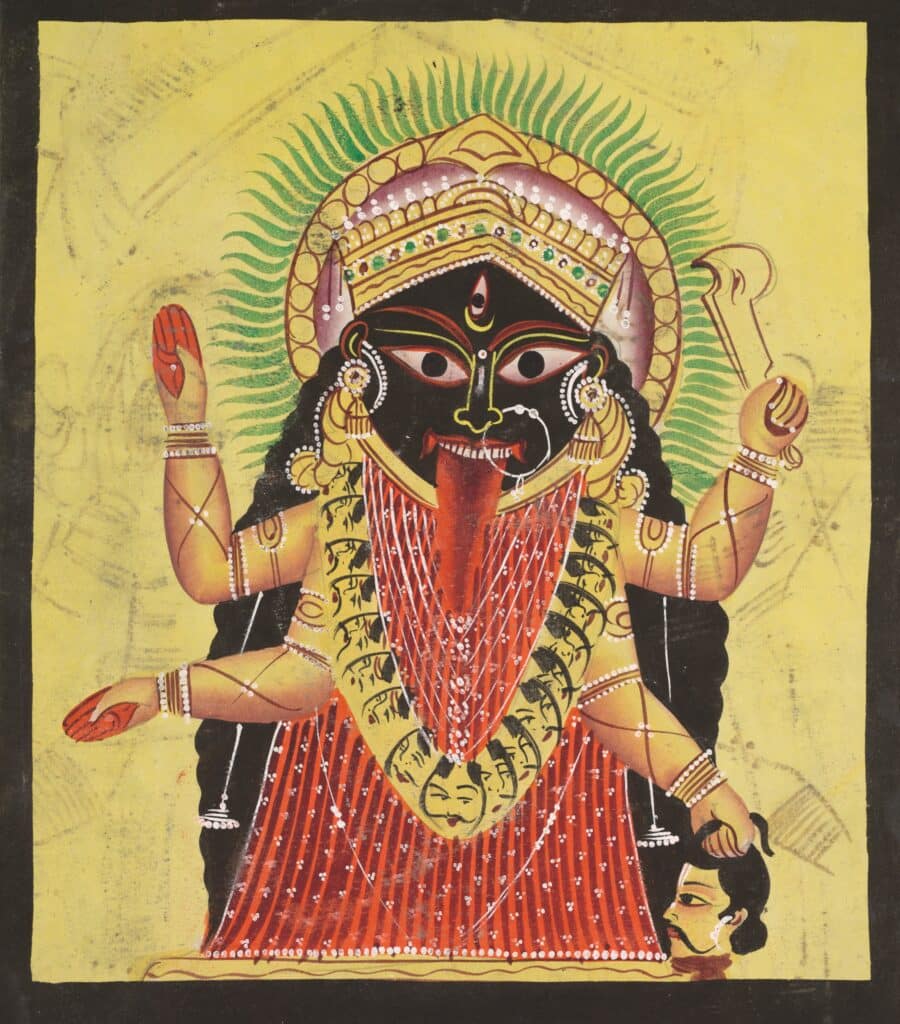
Warli Paintings
- The name of the painting comes from the people who have been carrying the painting tradition that goes back to 2500-3000 BC. They are called the Warlis, indigenous people that occupy mainly the Gujarat-Maharashtra border.
- It is vivid expression of daily & social events of Warli tribe, used by then to embellish the walls of village houses.
- It uses very shapes: a circle, a triangle and a square. The circle represents the sun and the moon, the triangle derived from mountains and pointed trees, the square indicates a sacred enclosure or a piece of land.
- Human and animal bodies are represented by two triangles joined at the tip; the upper triangle depicts the trunk and the lower triangle the pelvis. Their precarious equilibrium symbolizes the balance of the universe.
- The base is made of a mixture of mud, branches and cow dung that gives it a red ochre colour. For painting only white pigment is used, which is made of a mixture of gum and rice powder.
- The wall paintings are usually done for auspicious occasions like harvests and wedding. With time, the popularity of Warli painting has resulted in these being painted on a cloth on a base of red or black background using white poster colour.
- These paintings have close resemblance to the mural paintings of Bhimbetka in Madhya Pradesh.
- These ritualistic paintings have a central motif of a chaukat or chauk, which is surrounded by scenes portraying fishing, hunting, farming, dances, animals, trees and festivals. Among the Goddesses, Palaghata (goddess of fertility) is drawn and among the male gods, those spirits that have taken human form are represented.
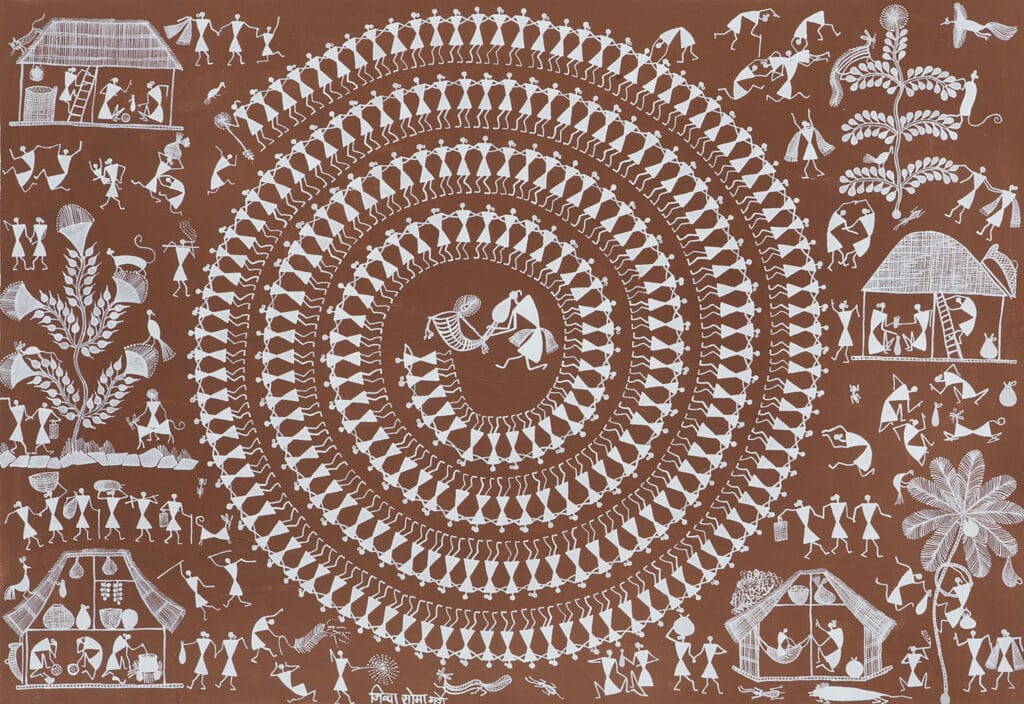
Paitkar Paintings
- The Paitkar paintings are also popularly known as the scroll paintings of Jharkhand.
- This old form of painting has cultural association with Ma Mansa, one of the most popular goddesses in tribal household.
- The tribal artists in Jharkhand have fostered this art of scroll painting that has long been used in storytelling performances and in socioreligious customs.
- The paintings that belong to this form have a common subject of ‘what happens to human life after death’.
- In Santhal tribe of Jharkhand, Jadu Patua or Paitkar painting is considered to have the capacity to send the wandering souls of the dead to heaven, and thus, help to free them of all pain.
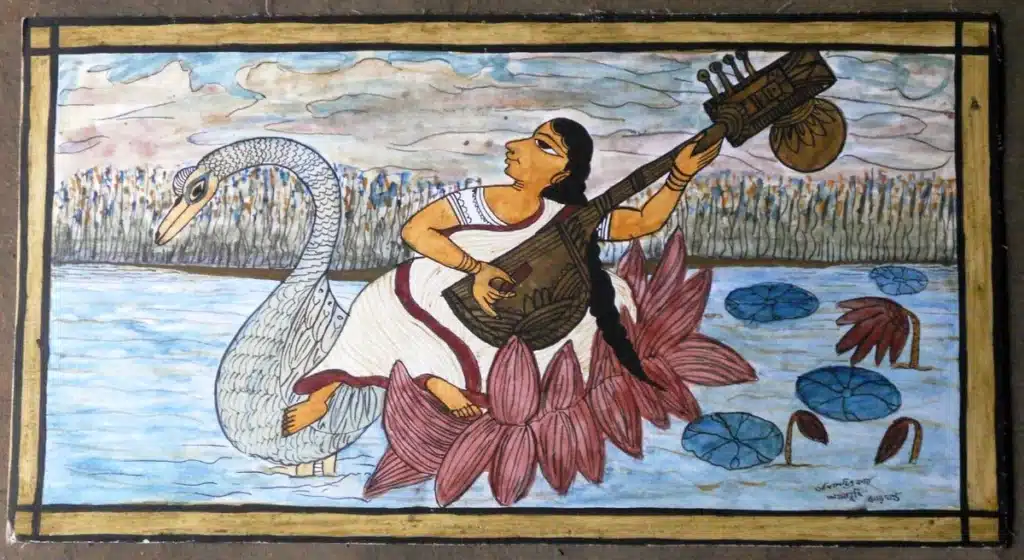
Patna Kalam Painting
- Patna School of Painting (also Patna Qalaam, or Patna Kalam) is a style of Indian painting which existed in Bihar, India in the 18th and 19th centuries.
- Patna Qalaam was the world’s first independent school of painting which dealt exclusively with the commoner and their lifestyle which also helped Patna Kalam paintings gain in popularity.
- The Principal centers were Patna, Danapur and Arrah.
- Origin:
- Patna Kalam is an off-shoot of Mughal painting. The Mughal style of painting matured in the regime of Jahangir, and his period was considered the golden era of Mughal paintings, but during the rule of Aurangzeb in the late 17th and early 18th century, artisans faced mass prosecution and aversion in art and painting.
- The painters migrated from Delhi looking for shelter in different places. One such group moved eastward and landed in Murshidabad under the patronage of the Nawab of Bengal and other local aristocrats, though British patrons were also important.
- In the mid-18th century, after the fall of The Nawab of Bengal and the subsequent decline of Murshidabad, the artisans started moving to the next biggest city in the east, Patna. In Patna they came under the patronage of local aristocracy and often Indophile scions of the early East India Company.
- Unlike Mughal paintings, which focused on royalty and court scenes, flag bearers of Patna Kalam were deeply influenced by the daily life of the common man, also a common subject in Company painting.
- Their main subjects were local festivals, ceremonies, bazaar scenes, local rulers, and domestic activities. The paintings were done on diverse surfaces such as paper, mica, and even ivory diskettes, that were used as brooches.
- A distinguishing characteristic of Patna Kalam is the lack of any landscape, foreground or background. Another characteristic was the development of the shading of solid forms.
- Patna Kalam paintings are painted straightway with the brush without marking with a pencil to delineate the contours of the picture and the procedure of painting is popularly known as ‘Kajli Seahi.
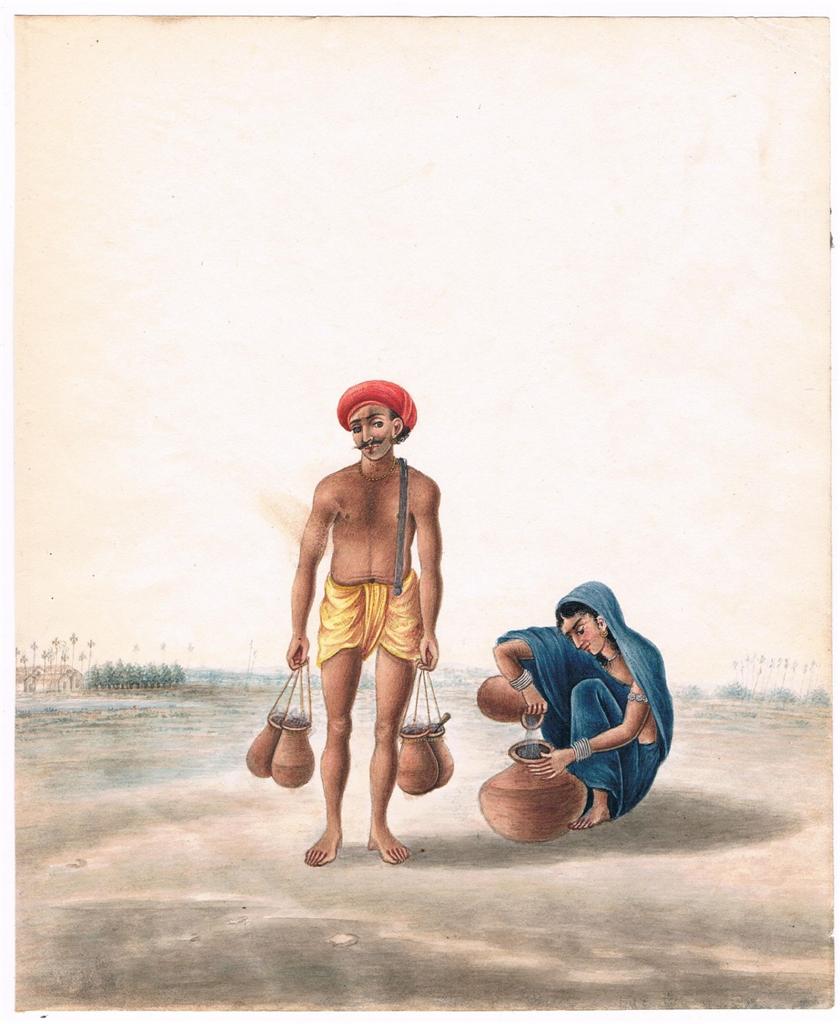
Kohvar and Sohrai Paintings
- Belong to the state of Jharkhand.
- These paintings are practiced exclusively by married women, during weddings and at harvest time, and the traditional skill is passed on to younger females of the clan.
- Comb cut or finger painted, Kohvar art celebrates marriage, and the wall painted Sohrai celebrates bumper crops.
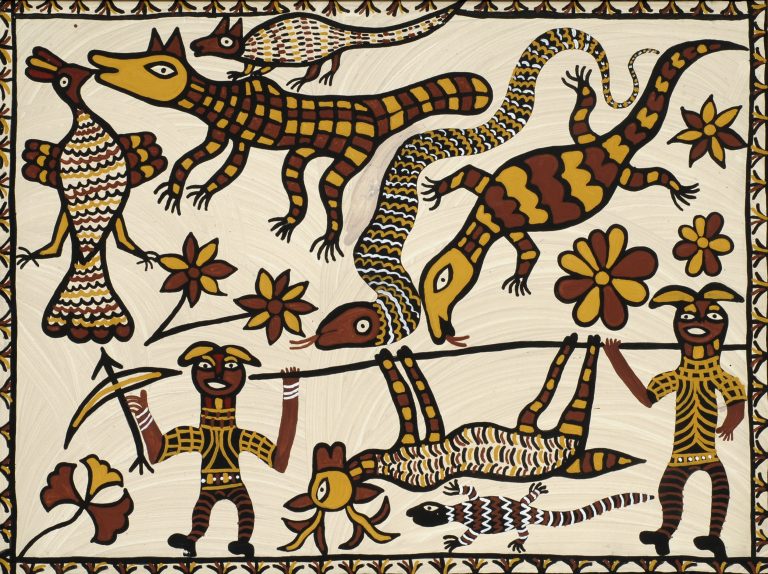
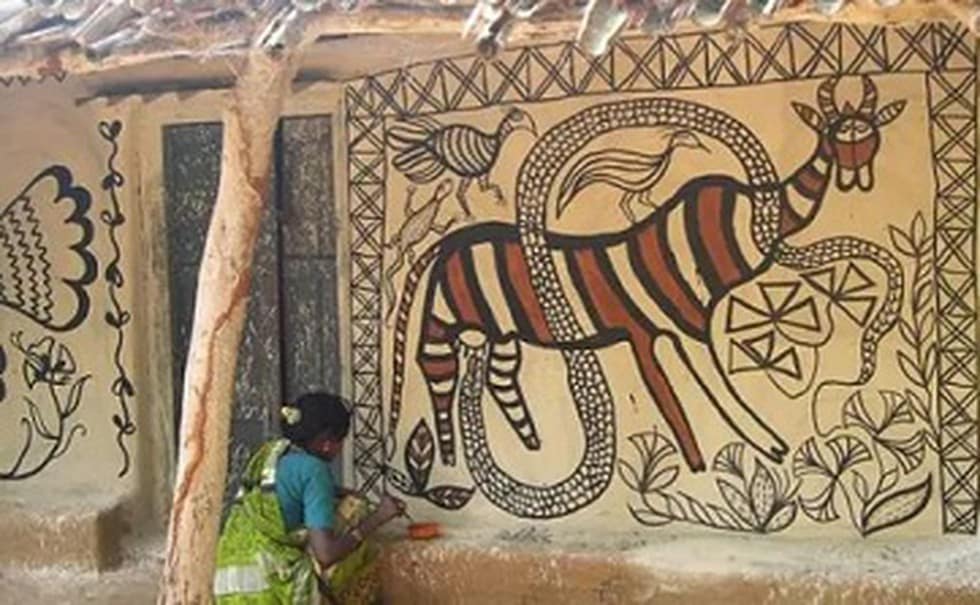
Kalamkari Paintings
- Kalamkari is a painting done by kalam (pen). These paintings are made in Andhra Pradesh. It is hand painted as well as block printing with vegetable dyes applied on cloth. Vegetable dyes are used for colour in the Kalam Kari work. The pen used is made of sharp pointed bamboo, used to regulate the flow of colours.
- A small place Sri-Kalahasti is the best known centre of Kalamkari art. This work is also found at Masaulipatnam in Andhra Pradesh.
- Owing to Muslim rulers in Golconda, the Masulipatnam kalamkari was widely influenced by Persian motifs and designs.
- This art is mainly related to decorating temple interiors with painted cloth panels, which was developed in the fifteenth century under the patronage of Vijaynagar rulers.
- Subjects are adopted from the Ramayana, the Mahabharata and Hindu religious mythology. This art form is a continuous legacy from father to son.
- The outlines and main features are done using hand carved blocks. The finer details are later done using the pen.
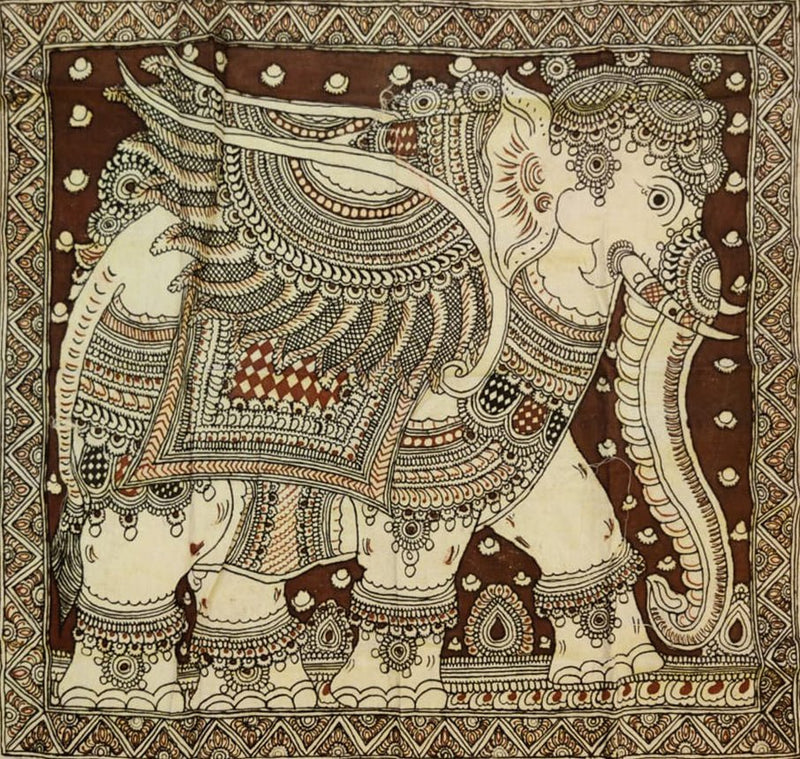
Phad Paintings
- It is a type of scroll painting famous in the state of Rajasthan, mainly found in the Bhilwara district.
- It is religious in nature and comprises of drawings of local deities, Pabuji and Devnarayan.
- Painted with vegetable colours on a long piece of cloth called phad, they are 15 ft or 30 ft long. The subjects have large eyes and round faces.
- These paintings are created using bright colours and subtle colours. The outlines of the paintings are first drawn in black and later filled with colours.
- The main themes of the phad paintings depict the deities and their legends and the stories of erstwhile Maharajas.
- The unique features of phad paintings are the bold lines and a two dimensional treatment of figures with the entire composition arranged in sections.
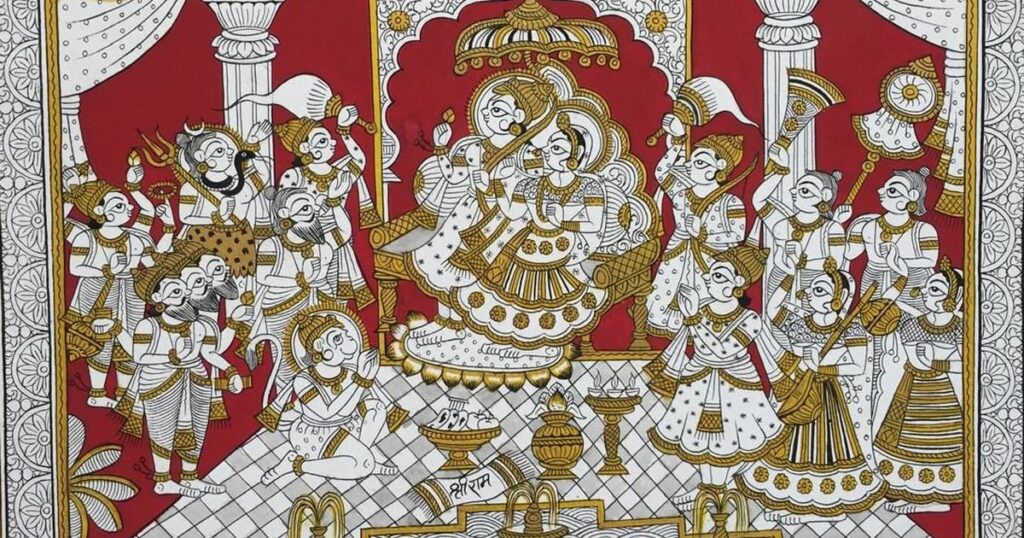
Manjusha Paintings
- Manjusha art is the folk art of Ang region which is based on Folklore of Bihula-Bishari. Ang region in modern era known as Bhagalpur (Bihar).
- These paintings are executed on boxes of jute and paper. It has a sequential representation of the story and is displayed in a series. This is also called a scroll painting.
- It is often referred to as Snake Paintings by foreigners as swirling snakes in the art depict the central character Bihula’s tale of love and sacrifice.

Thangka Paintings
- It is a Tibetan Buddhist painting on cotton, or silk, usually depicting a Buddhist deity, scene, or mandala.
- Presently belonging to Sikkim, Himachal Pradesh, Ladakh region and Arunachal Pradesh, Thangka were originally used as a medium of reverence that evoked the highest ideals of Buddhism. Traditionally made by Buddhist monks and particular ethnic group, the skill of these paintings has been passed from one generation to the other.
- Thangkas are painted on a base of cotton canvas (white background) with paints made from natural vegetable dyes or mineral dyes. The colours used in the paintings have their own significance.
- For example, red stands for intensity of passion, be it love or hatred, golden is for life or birth, white is for serenity, black depicts anger, green represents consciousness and yellow shows compassion.
- Once the painting is done, it is often framed in colourful silk brocade.
- Thangkas are traditionally kept unframed and rolled up when not on display, mounted on a textile backing somewhat in the style of Chinese scroll paintings.
- Because of their delicate nature, they have to be kept in dry places where moisture will not affect the quality of the silk.
- Most Thangkas were intended for personal meditation or instruction of monastic students. They often have elaborate compositions including many very small figures. A central deity is often surrounded by other identified figures in a symmetrical composition.
- Thangka serve as important teaching tools depicting the life of the Buddha, various influential lamas and other deities and bodhisattvas.
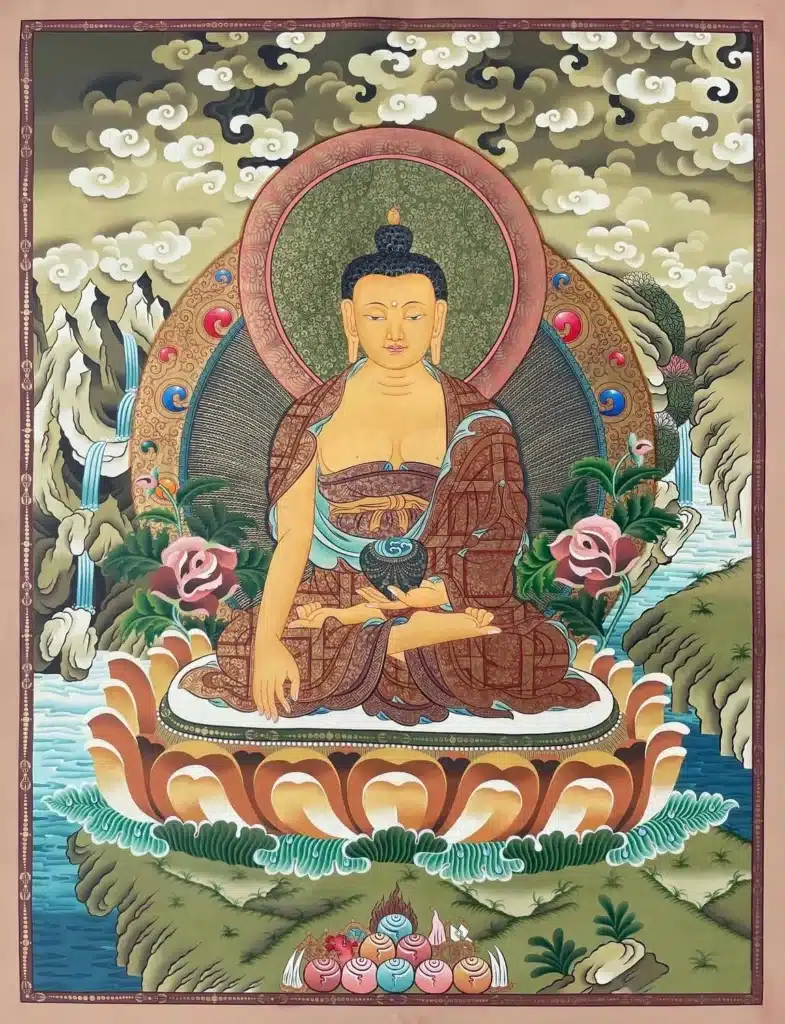
Patua Art Paintings
- Patua scroll painting is an art form native to West Bengal.
- It started out as a village tradition by painters telling Mangal Kavyas or auspicious stories of Hindu Gods and Goddesses.
- These paintings are done on pats or scrolls and for generations, the scroll painters or patuas have been going to different villages to sing their stories. Most Patuas are Muslims.
- The paintings are traditionally made from handmade paper, backed with cloth.
- Scrolls are typically 8 to 15 feet long and contain vibrantly painted scenes of a mythology or history story. As the scroll is unrolled frame by frame, the artist narrates mythological and historical stories through song, which typically lasts five to fifteen minutes.
- Traditionally these were painted on cloth and told religious stories; today they are painted with poster paints on sheets of paper sown together, usually to comment on political and social issues.
- These Patuas mostly come from Medinipur region, Murshidabad, North and South 24 Parganas and Birbhum districts.
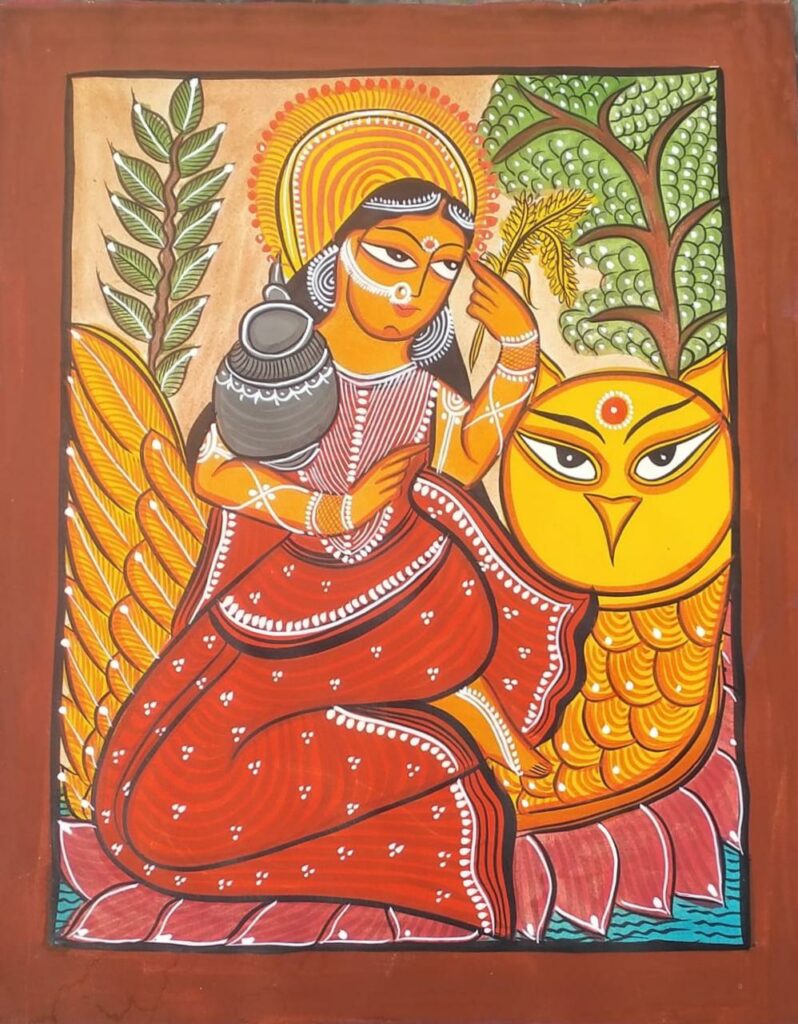
Pithoro Paintings
- Pithora is a ritualistic painting done on the walls by the Rathwa, Bhils and Bhilala tribes. The name Pithora also refers to the Hindu deity of marriage.
- These are murals from regions of states Gujarat and Madhya Pradesh and is said to serve religious and spiritual purpose.
- They are painted in the walls of the houses to bring peace and prosperity. They are drawn on special familyoccasions as a ritual. Depiction of animals are common especially horses.
- The walls of the houses are painted by professional artists belonging to the Rathawa caste.
- The main wall in the house is prepared, along with the adjacent walls. The surface is coated with a plaster of clay & cow dung, by the young unmarried girls.
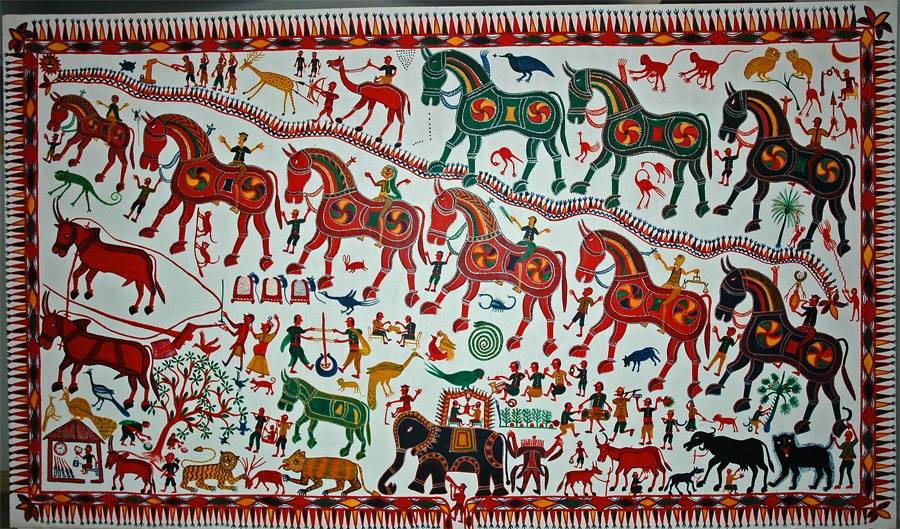
Pichchavi Paintings (Nathdwara Paintings)
- Nathdwara Painting refers to a painting tradition and school of artists that emerged in Nathdwara, a town in Rajsamand district in the Western state of Rajasthan in India.
- Nathdwara paintings are of different sub-styles of which Pichhwai paintings are the most popular.
- The word Pichwai derives from the Sanskrit words pich meaning back and wais meaning hanging.
- These paintings are cloth paintings hung behind the image of the Hindu god Shrinathji.

Cheriyal Scroll Painting
- Cheriyal Scroll Painting is a stylized version of Nakashi art, rich in the local motifs peculiar to the Telangana.
- The scrolls are depicted as a continuous story like comics or ballad by the Balladeer community.
- The scrolls are painted in a narrative format, much like a film roll or a comic strip, depicting stories from Indian mythology, and intimately tied to the shorter stories from the Puranas and Epics.
- Painted in vivid hues, mostly primary colors, with a predominance of red in the background, the paintings are characterised by the unbridled imagination of the local artisans. The iconography of even the major deities like Shiva, Vishnu, etc. has a strong local idiom.
- The common themes are from the Krishna Leela, Ramayana, Mahabharata, Shiva Puranam, Markandeya Puranam interspersed with the ballads and folk-stories of communities like Gauda, Madiga and so on.
- It has been accorded the Geographical Indication status in 2007.
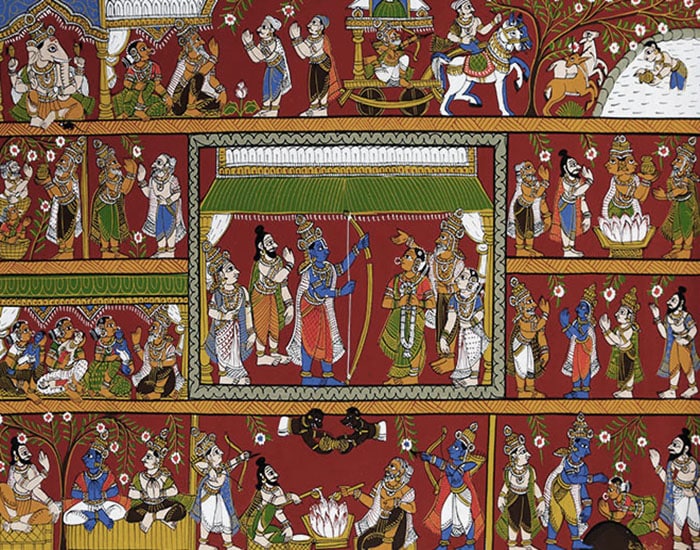
Kalamezhuthu
- Kalam (Kalamezhuthu) is unique form of art found in Kerala. It is similar to rangolis drawn in front of rural houses.
- It is essentially a ritualistic art practiced in temples and sacred groves of Kerala where the representation of deities like Kali and Lord Ayyappa, are made on the floor.
- Kalamezhuthu is practiced using natural pigments and powders, usually in five colours. The drawing is done with bare hands without the use of tools. The figures drawn usually have an expression of anger or other emotions.
- Lighted oil lamps placed at strategic positions brighten the colours.
- Ritual songs accompanied by a number of instruments are sung in worship of the deity, on completion of the ‘Kalam’.
- The drawing of a ‘Kalam‘ is started at an appointed time and it is erased immediately after the rituals related to it are over.
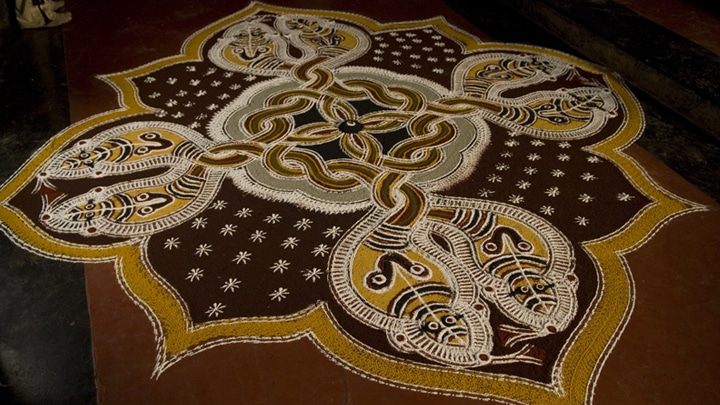
Saura Paintings, Odisha
- They are made by Saura Tribe of Odisha and are similar to Warli paintings.
- It is essentially a wall mural painting and is ritualistic. The Saura wall paintings are generally dedicated to Idital, the main deity of the Sauras.
- The painting is done mostly in white, while the backdrop of painting is red or yellow. The colours are extracted from minerals and plants. The human shapes are geometrical and stick–like.
- The designs have gained fashion in recent times with lots of T-shirts, female clothing, etc. featuring Saura style designs.
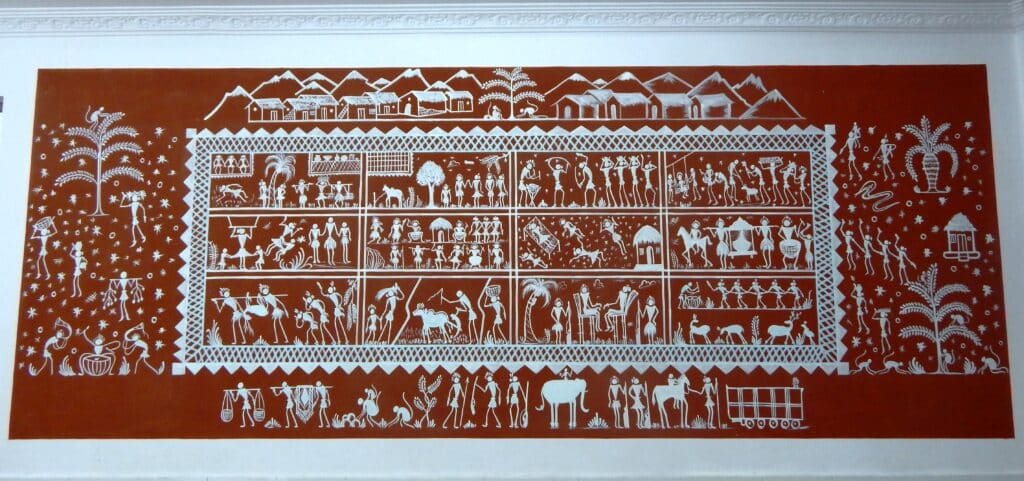
Chittara Paintings
- This folk craft is practised by the female members of the Delaware group in the Sagar district of Karnataka.
- Yellow seeds and rice paste, two organic elements, were used to create it. Their homes, which are red mud hamlets, have murals on the walls and floors.
- Usually, these paintings depict scenes from the daily lives of tribal people, such as animals and birds, flowers used in pooja, rituals, gods, socioeconomic activities, gifts for children, etc.
- Natural resources like toasted rice, trees, vegetables, minerals, and rocks and stones provide them with their colour. Additionally, they paint with a delicate jute brush called a “Pundi.” This traditional artwork is generally produced on auspicious occasions and has intricate themes and geometric designs.
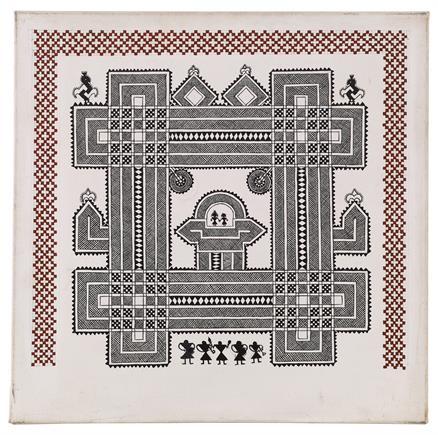
Tanjore Painting
- Ancient Indian folk art known as Tanjore or Thanjavur painting has its roots in the South Indian town of Thanjavur,that dates back to the year 1600.
- These paintings are well-known for their use of gold foil, which gives the piece a surreal appearance, their use of brilliant hues and semi-precious stones, as well as their beautiful panel painting on a wood board with a deity as the main subject.
- Hindu deities, saints, scenes from Hindu Puranas, Sthala-Puranas, and mythological subjects are among the principal themes of Tanjore paintings.
- Palagi Padam, which translates to “image on a wooden plank,” is another name for these panel paintings that were created on wooden planks. Tanjore’s artwork is exquisitely lovely and graceful.
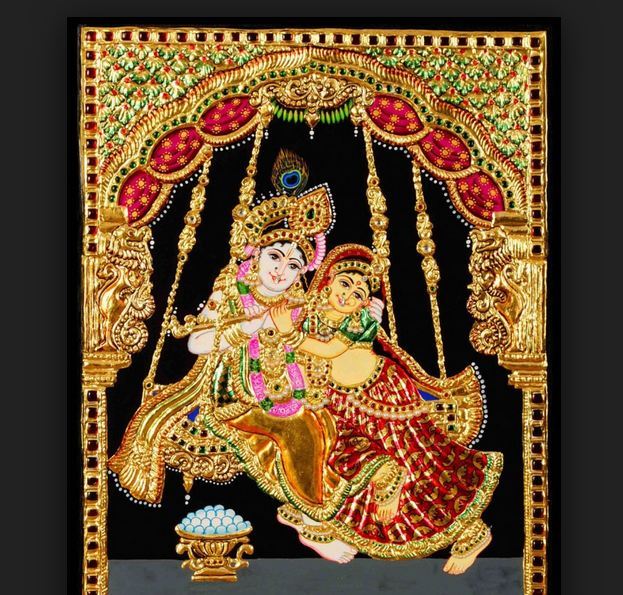
Gond painting
- Indian folk and tribal art make up this genre. People from the Gond community in Madhya Pradesh practise them. For more than 1400 years, this art form has been practised.
- Typically, they show flora and fauna, people going about their daily lives, gods, holidays, and celebrations. They reproduce natural phenomena, historical events, ceremonies, and mythological tales. These paintings are strong, vivid, and colourful with a great deal of meticulous detail.
- The art form became so well-known because of Jangarh Singh Shyam, a Gond legend and flag-bearer of Gond art.
- The original origins of the colours utilised in Gond art were things like cow dung, sap from plants, charcoal, colourful earth, mud, flowers, and leaves. But nowadays, artists use synthetic colours such as acrylic colours, watercolours, oil paints, etc.
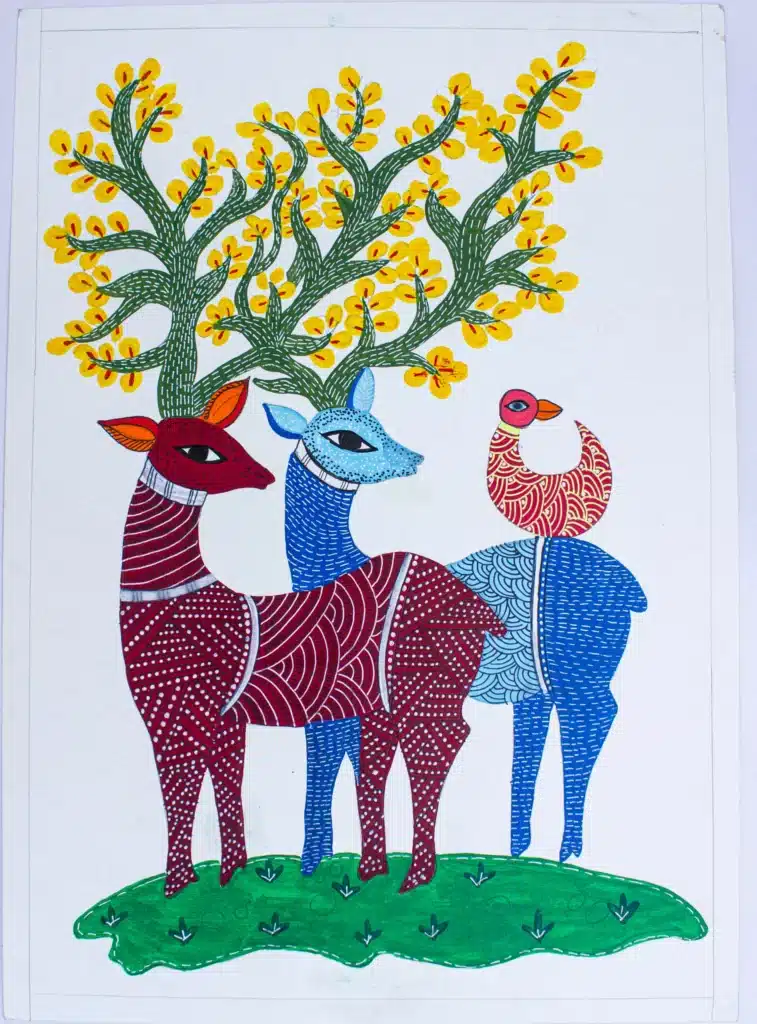
Bhil Art
- This is another tribal art form practised by the Bhils. The Bhils reside in Madhya Pradesh, Gujarat, Rajasthan, and Maharashtra and are highly superstitious people.
- The Bhil paintings are traditionally done on the clay walls of their village homes and neem sticks, twigs, and natural colours are used to do so.
- The bright and vibrant colours are extracted from turmeric, flour, vegetables, oil, and leaves.
- These Bhil paintings depict the everyday life of this tribe and they usually contain large shapes covered with uniform dots in numerous patterns and colours. These dots and patterns on a Bhil painting generally represent something that the artist wants like ancestors or deities.
- Some common depictions include nature, flora and fauna, Bhil deities, births and deaths, rituals, and festivals.
